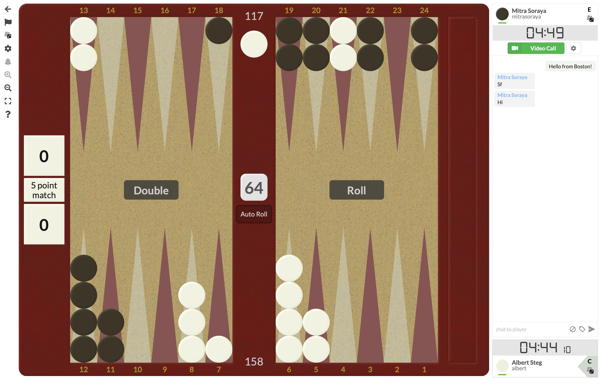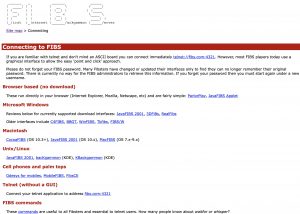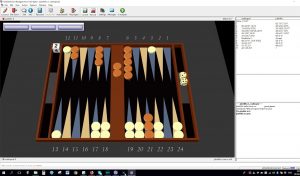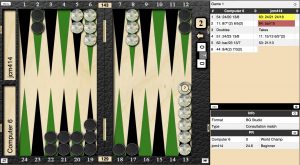There are currently several terrific places to play backgammon online. Each site has its own personality, offering different features, interfaces, and ratings systems — and drawing a somewhat different community of players. They also afford you an opportunity to observe matches between skilled opponents. Here are a few of the more popular ones. You can visit the site by clicking on the screen image!
Backgammon Hub
 Backgammon Hub strikes an idea balance between simplicity of use and range of features, making it the preferred site for our weekly NEBC online tournament matches. The first thing you might notice is that players on the site are identified by their real names, which not only means that you can get to know players you might one day meet at a live tournament in a distant land, but also that the rude, antisocial behavior that spoils many sites with anonymous participants is largely eliminated. This is a backgammon site for real-world competitors, and one that most simulates the feel of a real local club. There’s even a built-in videoconferencing feature so you can interact with your opponent — or engage with a coach in “Teacher Mode.”
Backgammon Hub strikes an idea balance between simplicity of use and range of features, making it the preferred site for our weekly NEBC online tournament matches. The first thing you might notice is that players on the site are identified by their real names, which not only means that you can get to know players you might one day meet at a live tournament in a distant land, but also that the rude, antisocial behavior that spoils many sites with anonymous participants is largely eliminated. This is a backgammon site for real-world competitors, and one that most simulates the feel of a real local club. There’s even a built-in videoconferencing feature so you can interact with your opponent — or engage with a coach in “Teacher Mode.”
One feature that contributes to that is a wonderful “Ladder” competition that helps you manage challenges to other members in an ongoing “king of the hill competition. Another nice community feature is the “Daily Puzzle” — a backgammon position you’re invited to answer and then discuss with other members — the site even keeps a running tally of your personal record.
There are relatively few players own the site at any given moment compared to the other platforms, yet it never seems to take long to find an opponent. The game graphics and controls are very clean and easy to use. When you log in, simply explore the relatively few tabs and buttons on the home screen to familiarize yourself with your match history, match invitation system, and handy, responsive feedback / request feature.
Backgammon Galaxy
 Perhaps the most popular and easiest to use online backgammon platform is Backgammon Galaxy. Simply log on, indicate your preferred match length and clock speed, and the site will pair you up with an opponent. The site has a clean, simple style based on a playful space theme, and the platform runs equally well on desktop computers and a cross-platform smartphone app.
Perhaps the most popular and easiest to use online backgammon platform is Backgammon Galaxy. Simply log on, indicate your preferred match length and clock speed, and the site will pair you up with an opponent. The site has a clean, simple style based on a playful space theme, and the platform runs equally well on desktop computers and a cross-platform smartphone app.
Your account is fueled by ‘virtual coins,” an allowance of which are available on a daily basis, and which are won or lost to opponents based on your match results. So the site is free to play on — to a point. If you run out of coins, you can wait for some freshly minted ones tomorrow, or you can purchase extra coins to feed your habit.
One of the great features here is that after each game, you may review a log of your match which highlights your errors for easy study. A new “blunder database” feature categorizes your mistakes into tactical categories, a terrific study aid for serious players. This feature, as well as a doubled daily allowance of coins and a more accurate level of game analysis, is available to “Star Members” who pay a reasonable monthly subscription fee.
The only downside of this highly polished site is a lack of flexibility. Apart from a somewhat cumbersome “Play a Friend” feature, you don’t choose your opponents, and matches are limited to 1, 3, 5, or 7 points only. There is no “chat” feature, only a limited menu of emojis and stock greetings, so you won’t make new friends here. But neither will you have to endure the offensive remarks that plagued the older version of Galaxy — making this a safe site for everyone, including kids.
A sure sign that a site is getting something right is that even when players complain about it, they continue to play there in droves.
Backgammon Studio Heroes
“Heroes,” as it has come to be known, has established itself as the go-to platform for the explosion of international online backgammon competitions driven by the global pandemic lockdown. Site master Terje Pedersen has provided dedicated Tournament Rooms that make it easy for tournament directors to set up standardized match parameters, and for participants to gather and find their assigned opponents with ease.
Backgammon play on Heroes is exquisitely customizable. Everything from the board colors and dice size to the input controls, sound effects, mouse behavior and chat options can be set just the way you want them. Likewise, there is a vast array of match types and formats to choose from, including Hypergammon, Paskogammon, and several others few will have heard of. With all of these options comes a certain degree of bewilderment, but it’s worth the effort to get to know this site, which has been described as “Love at third sight.”
An interesting mode of play has emerged as a popular favorite on BG Studio: the “Consultation Match.” In it, your plays are evaluated in real time via a GNU back-end robot and immediately flagged green/yellow/red when incorrect, according to the size of the error, and your cumulative match PR is displayed. While you may find this irksome at first, the effect of this constant “consulting” is that you begin to take as much interest in your error-performance as you do in actually winning or losing the match. And that’s good for your game.
Terje Pedersen’s “Heroes” playing site used to be part of Backgammon Studio, and the connection between the two can be a little puzzling. See the Backgammon Studio entry on our the “Websites” Resource page for a description of some of the incredible learning tools available here.
First Internet Backgammon Server (FIBS)
 Players of a certain age recall fondly the wonder that emerged in 1992 when FIBS came online, allowing players at terminal screens all around the world to play backgammon at any hour of the day or night. Popular web browsers like Mosaic had not yet appeared, so all the action was depicted as a pattern of ASCI symbols: X’s and O’s for checkers cleverly patterned on a board made up of /’s and |’s and \’s. There was a menu of speaking commands you could use (shout, whisper, kibitz . . . ) to have your messages appear on selected participants screens.
Players of a certain age recall fondly the wonder that emerged in 1992 when FIBS came online, allowing players at terminal screens all around the world to play backgammon at any hour of the day or night. Popular web browsers like Mosaic had not yet appeared, so all the action was depicted as a pattern of ASCI symbols: X’s and O’s for checkers cleverly patterned on a board made up of /’s and |’s and \’s. There was a menu of speaking commands you could use (shout, whisper, kibitz . . . ) to have your messages appear on selected participants screens.
FIBS has grown with the times, and you can still access it in the old style with a telnet screen — but you can also select a “front end” program to provide a more inviting “graphical interface” to the site and join a BG community that’s been going at it for more than a quarter of a century!
GridGammon
 GridGammon began life in 1996 as GamesGrid, and after a long evolution of identity, emerged as the favored site for the USBGF Online Circuit matches, as well as for many other international online competitions.
GridGammon began life in 1996 as GamesGrid, and after a long evolution of identity, emerged as the favored site for the USBGF Online Circuit matches, as well as for many other international online competitions.
To play on GridGammon you need an invitation from someone who is already a member, but you can request a Gridgammon account via this USBGF submission form.
When you get your account set up, you’ll go to the GamesGrid site and download the client software to your desktop computer. Fire it up, log in, and you’re off to the races.
Unfortunately, however, the Mac client lacks many features, including the ability to change the appearance and size of your board, or to edit your personal info and Preferences. Worse yet, the Mac software will not run on any Apple computer running an Operating system newer than Mojave (10.14), and no updates are anticipated.
In the event that GridGammon is updated to accommodate Mac users, please contact info@nebackgammon.org so that we may correct this listing.
The NEBC does not recommend playing backgammon for money over the internet. While it is very unlikely that the game will be “rigged” in any way, it is always possible that an opponent may be consulting sophisticated backgammon analysis software unbeknownst to you, making them virtually impossible to beat in the long run.

